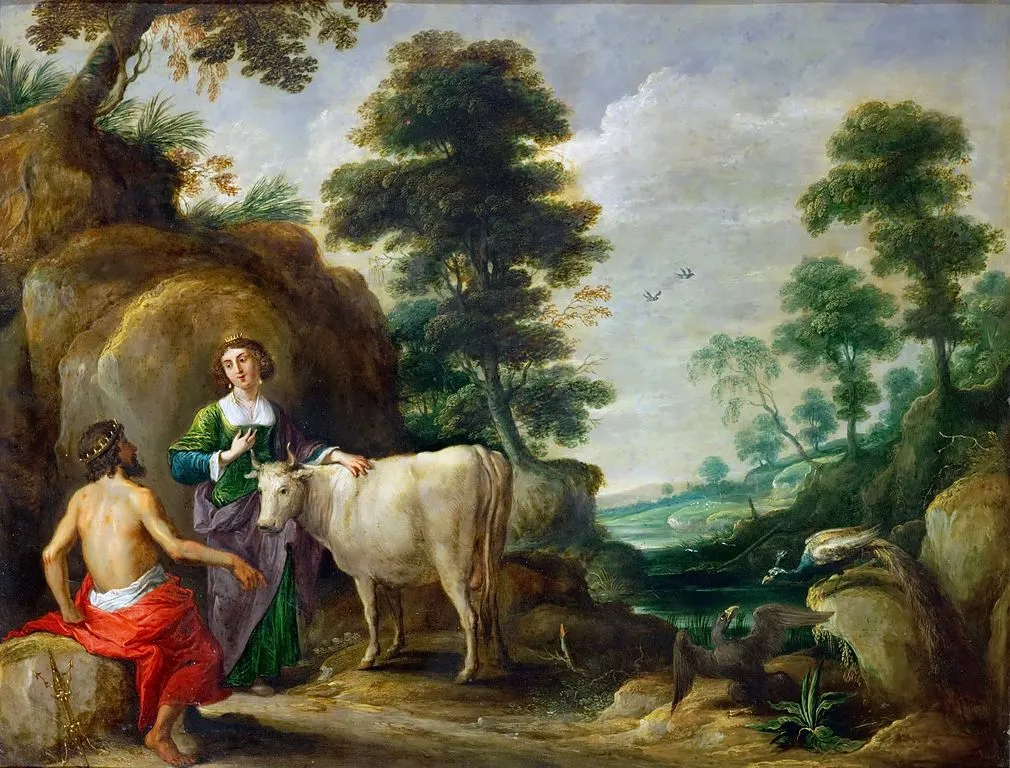Greek mythology composes a lot of intricate tales involving gods and mortals, with one such story focusing on the entwined destinies of Hera, Io, and Zeus. These mythological figures embody love, jealousy, transformation, and prophecy. The myth of Hera, Zeus, and Io, a mortal who captured Zeus’ affection and endured Hera’s wrath, provides a fascinating insight into the complex dynamics of divine relationships.

The tale of Io’s transformation, her tormented wanderings, and the prophecy she received from the chained Titan Prometheus illustrates the timeless themes of love, sacrifice, and destiny that continue to resonate in our understanding of Greek mythology.
The Characters
Zeus: The ruler of the twelve Olympian deities and the paramount god in ancient Greek religion, Zeus is frequently recognized as the Father, the deity of thunder, and the ‘cloud-gatherer’. Occupying a lofty seat on Mount Olympus, Zeus administered justice, upholding order in both the divine realm and the mortal world.
Hera: Hera is the goddess of marriage, women, and family, also serving as the guardian of women during childbirth in Greek mythology. As the queen of the twelve Olympian gods on Mount Olympus, she is Zeus’ sister and spouse, born to the Titans Cronus and Rhea.
Io: She was an Argive princess, who stood among Zeus’ mortal lovers in Greek Mythology. She held the lineage of numerous kings and heroes, including Perseus and Cadmus. Notably, the astronomer Simon Marius bestowed the name Io on one of Jupiter’s moons in 1614.
Zeus Falls In Love With Io
o, a priestess of the goddess Hera in the city of Argos, central Greece, was renowned for her beauty and youth. Caught in the fervent affection of Zeus, the mighty god, Io became the object of his ardent desires. Despite Io’s resolute efforts to fend off Zeus’ advances, he cunningly cloaked himself in clouds to approach her. Succumbing to his insatiable passion, Zeus engaged in a romantic encounter with Io.
Hera Turns Io Into a Cow
However, Hera, Zeus’ envious wife, soon uncovered their liaison. In a fit of jealous rage, Hera inflicted a punitive transformation upon Io, turning her into a pristine white cow. This saddening tale underscores the intricate dynamics of divine relationships while serving as an allegory for the consequences of forbidden love and the ensuing sufferings of mortal beings like Io.
Hermes And The hundred-eyed dog Argus
Io found herself bound to an olive tree within the sacred Heraion temple outside Argos, guarded by the vigilant hundred-eyed dog, Argus Panoptes, preventing Zeus from intervening. Yet, Zeus devised a plan to liberate Io and outwit Hera indirectly. He tasked Hermes, the messenger god, with the formidable mission of slaying Argus.

This proved challenging, as Argus had fifty eyes that were either awake or asleep at all times. Taking on the guise of a skilled shepherd adept in music and storytelling, Hermes managed to lull all of Argus’ eyes into slumber before ultimately killing him. Legend recounts that Hera then placed Argus’ hundred eyes onto the tail of her cherished bird, the peacock, symbolizing her power.
Io Wanders Around As A Cow
Overwhelmed by humiliation, Hera reached a breaking point. In response, she dispatched a relentless gadfly to torment Io, now transformed into a bovine form, driving her to madness. Io’s tormented wanderings took her across various lands, the incessant gadfly stings fueling her distress. Amid her journey, she traversed the region between Propontis and the Black Sea. This passage, forever marked by her plight, came to be known as Bosporus, meaning “the passage of the cow.”
The Prophecy – Io Meets Prometheus
During her journey, Io arrived at Mount Caucasus and encountered the Titan Prometheus, who was bound by Zeus as punishment for giving fire to humanity, a privilege previously reserved for the Gods. As a consequence, Prometheus was perpetually chained to the rocks, enduring the agony of an eagle feasting on his liver daily, only for it to regenerate overnight and the torment to continue.
In her travels, Io found solace with Prometheus in his suffering. He prophesied that she would one day regain her human form, bear Zeus’ children, and her descendants would eventually free him from his torment. After many years of wandering, Io eventually arrived in Egypt, where Zeus restored her human form.
Descendants Of Io
Io, the mythical figure, bore offspring from Zeus – a son named Epaphus and a daughter named Keroessa. Epaphus went on to establish the city of Memphis in Egypt, naming it after his spouse. Keroessa, on the other hand, mated with the sea god Poseidon, giving birth to a son named Byzas, who later founded Byzantium, now recognized as Constantinople.
Io’s journey continued as she wed Telegonus, the Egyptian king, and their grandson Danaus, along with his fifty daughters known as the Danaides, returned to Greece. In a lineage spanning eleven generations, Io’s descendant, the renowned Hercules, would ultimately liberate Prometheus from his eternal torment. This lineage of Io’s descendants would also play significant roles in forming the royal houses of Thebes and Argos.
Summary
Io, a woman from Argos, Greece, captured the attention of Zeus, who disguised as a cloud and seduced her. Hera, Zeus’ wife, transformed Io into a cow out of jealousy. Guarded by the hundred-eyed dog Argus, Io was later freed by Hermes, who lulled Argus to sleep and killed him. Hera tormented Io with a gadfly, causing her to wander like a mad cow.
Io met the chained Titan Prometheus, who prophesied her return to human form bearing Zeus’ children, and predicted that her descendants would release Prometheus. After reaching Egypt, Zeus restored Io’s human form, and she gave birth to Epaphus and Keroessa. Keroessa’s descendants established cities like Memphis and Byzantium, while Io’s lineage led to Hercules and the royal houses of Thebes and Argos.
Also Read: The Myth of Aphrodite and Ares
